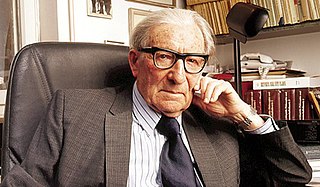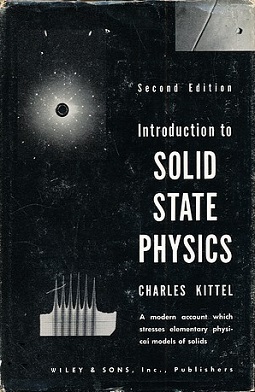Contents
This article needs additional citations for verification .(January 2021) |
This article needs additional citations for verification .(January 2021) |
| Name | Description |
|---|---|
| Bloch's theorem | Fundamental theorem in condensed matter physics describing the wavefunction of a particle confined in a periodic medium |
| Bloch electron | An electron that behaves the Schrodinger equation with a periodic potential, as described by Bloch's theorem. [1] |
| Bloch form | A planewave multiplied by a periodic function [2] |
Bloch state
| Bloch states (also called Bloch functions, Bloch wavefunction, and Bloch wave) are the solutions to Schrodinger's equation in a periodic potential—given by the Bloch form—as described by Bloch's theorem. |
| Bethe–Bloch formula | Quantifies the energy loss per unit distance for fast-moving charged particles in a material |
| Bloch–Grüneisen temperature | Characteristic electronic energy scale in materials with a small Fermi surfaces [3] |
| Bloch–Siegert shift | Quantum phenomenon resulting in the shift of the dipole resonant frequency in certain systems |
| Bloch equations | Set of equations used to calculate the nuclear magnetization as a function of time in nuclear magnetic resonance |
Bloch oscillations
| Driven oscillation of a particle in a periodic potential
|
| Bloch spectrum | A type of energy spectrum |
| Bloch sphere | Geometric representation of the pure state space of a qubit |
| Bloch T3/2 law | The formula describing the fractional change of magnetization in the thermal excitation of magnons. [5] |
| Bloch wall | The transitional region between adjacent magnetic domains—each with a magnetization pointing in a different direction—where the magnetization direction varies [6] |
Maxwell–Bloch equations
| Equations describing the dynamics of a two-state quantum system interacting with an optical resonator |
| Semiconductor Bloch equations | Equations describing the optical response of semiconductors to lasers and other coherent light sources |

Quantum mechanics is a fundamental theory in physics that describes the behavior of nature at and below the scale of atoms. It is the foundation of all quantum physics, which includes quantum chemistry, quantum field theory, quantum technology, and quantum information science.
Atomic, molecular, and optical physics (AMO) is the study of matter–matter and light–matter interactions, at the scale of one or a few atoms and energy scales around several electron volts. The three areas are closely interrelated. AMO theory includes classical, semi-classical and quantum treatments. Typically, the theory and applications of emission, absorption, scattering of electromagnetic radiation (light) from excited atoms and molecules, analysis of spectroscopy, generation of lasers and masers, and the optical properties of matter in general, fall into these categories.
Solid-state physics is the study of rigid matter, or solids, through methods such as solid-state chemistry, quantum mechanics, crystallography, electromagnetism, and metallurgy. It is the largest branch of condensed matter physics. Solid-state physics studies how the large-scale properties of solid materials result from their atomic-scale properties. Thus, solid-state physics forms a theoretical basis of materials science. Along with solid-state chemistry, it also has direct applications in the technology of transistors and semiconductors.

In mathematics and solid state physics, the first Brillouin zone is a uniquely defined primitive cell in reciprocal space. In the same way the Bravais lattice is divided up into Wigner–Seitz cells in the real lattice, the reciprocal lattice is broken up into Brillouin zones. The boundaries of this cell are given by planes related to points on the reciprocal lattice. The importance of the Brillouin zone stems from the description of waves in a periodic medium given by Bloch's theorem, in which it is found that the solutions can be completely characterized by their behavior in a single Brillouin zone.
The molar heat capacity of a chemical substance is the amount of energy that must be added, in the form of heat, to one mole of the substance in order to cause an increase of one unit in its temperature. Alternatively, it is the heat capacity of a sample of the substance divided by the amount of substance of the sample; or also the specific heat capacity of the substance times its molar mass. The SI unit of molar heat capacity is joule per kelvin per mole, J⋅K−1⋅mol−1.
An intrinsic semiconductor, also called a pure semiconductor, undoped semiconductor or i-type semiconductor, is a semiconductor without any significant dopant species present. The number of charge carriers is therefore determined by the properties of the material itself instead of the amount of impurities. In intrinsic semiconductors the number of excited electrons and the number of holes are equal: n = p. This may be the case even after doping the semiconductor, though only if it is doped with both donors and acceptors equally. In this case, n = p still holds, and the semiconductor remains intrinsic, though doped. This means that some conductors are both intrinsic as well as extrinsic but only if n is equal to p.
In solid-state physics, the nearly free electron model is a quantum mechanical model of physical properties of electrons that can move almost freely through the crystal lattice of a solid. The model is closely related to the more conceptual empty lattice approximation. The model enables understanding and calculation of the electronic band structures, especially of metals.

Thermal physics is the combined study of thermodynamics, statistical mechanics, and kinetic theory of gases. This umbrella-subject is typically designed for physics students and functions to provide a general introduction to each of three core heat-related subjects. Other authors, however, define thermal physics loosely as a summation of only thermodynamics and statistical mechanics. Thermal physics can be seen as the study of system with larger number of atom, it unites thermodynamics to statistical mechanics.
In crystallography, a Frenkel defect is a type of point defect in crystalline solids, named after its discoverer Yakov Frenkel. The defect forms when an atom or smaller ion leaves its place in the structure, creating a vacancy and becomes an interstitial by lodging in a nearby location. In elemental systems, they are primarily generated during particle irradiation, as their formation enthalpy is typically much higher than for other point defects, such as vacancies, and thus their equilibrium concentration according to the Boltzmann distribution is below the detection limit. In ionic crystals, which usually possess low coordination number or a considerable disparity in the sizes of the ions, this defect can be generated also spontaneously, where the smaller ion is dislocated. Similar to a Schottky defect the Frenkel defect is a stoichiometric defect. In ionic compounds, the vacancy and interstitial defect involved are oppositely charged and one might expect them to be located close to each other due to electrostatic attraction. However, this is not likely the case in real material due to smaller entropy of such a coupled defect, or because the two defects might collapse into each other. Also, because such coupled complex defects are stoichiometric, their concentration will be independent of chemical conditions.
A Schottky defect is an excitation of the site occupations in a crystal lattice leading to point defects named after Walter H. Schottky. In ionic crystals, this defect forms when oppositely charged ions leave their lattice sites and become incorporated for instance at the surface, creating oppositely charged vacancies. These vacancies are formed in stoichiometric units, to maintain an overall neutral charge in the ionic solid.
In superconductors, the London penetration depth characterizes the distance to which a magnetic field penetrates into a superconductor and becomes equal to times that of the magnetic field at the surface of the superconductor. Typical values of λL range from 50 to 500 nm. It was first derived by Geertruida de Haas-Lorentz in 1925, and later by Fritz and Heinz London in their London equations (1935).

Max Jammer, was an Israeli physicist and philosopher of physics. He was born in Berlin, Germany. He was Rector and Acting President at Bar-Ilan University from 1967 to 1977.
Paul McEuen is an American physicist. He received his B.S. in engineering physics at the University of Oklahoma (1985), and his Ph.D. in applied physics at Yale University (1991). After postdoctoral work at MIT (1990–1991), he became an assistant professor at the University of California, Berkeley. He moved to Cornell University in 2001, where he is currently the Goldwin Smith Professor of Physics. He is an expert on the electrical property of carbon nanotubes and is a member of the National Academy of Sciences.
Charles Kittel was an American physicist. He was a professor at the University of California, Berkeley from 1951 and was professor emeritus from 1978 until his death.
Richard Elliss Bodenham Makinson, also R.E.B. or Dick Makinson, was an Australian physicist known for his contributions to solid-state physics and amorphous semiconductors.
Manganese(II) telluride is an inorganic compound with the chemical formula MnTe.

In solid-state physics, the valence band and conduction band are the bands closest to the Fermi level, and thus determine the electrical conductivity of the solid. In nonmetals, the valence band is the highest range of electron energies in which electrons are normally present at absolute zero temperature, while the conduction band is the lowest range of vacant electronic states. On a graph of the electronic band structure of a semiconducting material, the valence band is located below the Fermi level, while the conduction band is located above it.
In condensed matter physics, the Slater–Pauling rule states that adding an element to a metal alloy will reduce the alloy's saturation magnetization by an amount proportional to the number of valence electrons outside of the added element's d shell. Conversely, elements with a partially filled d shell will increase the magnetic moment by an amount proportional to number of missing electrons. Investigated by the physicists John C. Slater and Linus Pauling in the 1930s, the rule is a useful approximation for the magnetic properties of many transition metals.

Introduction to Solid State Physics, known colloquially as Kittel, is a classic condensed matter physics textbook written by American physicist Charles Kittel in 1953. The book has been highly influential and has seen widespread adoption; Marvin L. Cohen remarked in 2019 that Kittel's content choices in the original edition played a large role in defining the field of solid-state physics. It was also the first proper textbook covering this new field of physics. The book is published by John Wiley and Sons and, as of 2018, it is in its ninth edition and has been reprinted many times as well as translated into over a dozen languages, including Chinese, French, German, Hungarian, Indonesian, Italian, Japanese, Korean, Malay, Romanian, Russian, Spanish, and Turkish. In some later editions, the eighteenth chapter, titled Nanostructures, was written by Paul McEuen. Along with its rival Ashcroft and Mermin, the book is considered a standard textbook in condensed matter physics.

Solid State Physics, better known by its colloquial name Ashcroft and Mermin, is an introductory condensed matter physics textbook written by Neil Ashcroft and N. David Mermin. Published in 1976 by Saunders College Publishing and designed by Scott Olelius, the book has been translated into over half a dozen languages and it and its competitor, Introduction to Solid State Physics, are considered the standard introductory textbooks of condensed matter physics.